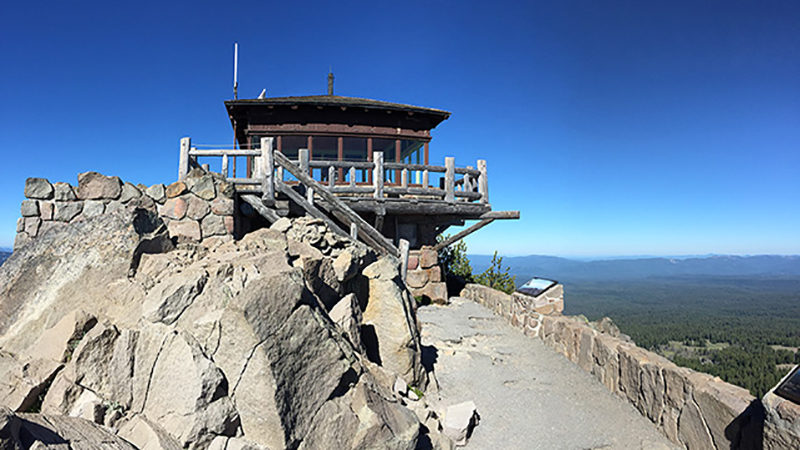
Crater Lake National Park’s 33 mile, scenic Rim Drive circles the deep blue lake and provides access to more than 30 scenic viewpoints and trailheads. After enjoying the lake views — our first of the day — from Discovery Point, we headed to the Watchman Overlook. This was to be a major destination for us as it is also the trailhead for one of the most popular trails in the park: the incredible Watchman Trail that switchbacks up the mountain to an old fire lookout at the top of Watchman Peak.
Watchman Overlook is located 3.7 miles northwest of Rim Village on West Rim Drive between the Discovery Point and Merriam Point overlooks. When we pulled into the large parking area, we realized our hiking plans had been squashed. Even though it was late July, our visit to Crater Lake National Park was during the season’s opening weekend and the Watchman Trail was still closed due to snow.
I was devastated, but at least we still got to enjoy the amazing views of Watchman Peak, Crater Lake, and Wizard Island, a cinder cone that erupted in Crater Lake nearly 7,500 years ago. The view was awesome that we decided to have our picnic lunch here!

About Watchman Observation Station
Watchman Peak, named by William Gladstone Steel in 1886, is home to the Watchman Observation Station, a two-story fire lookout building and national park museum. At the base of the peak, Watchman Overlook provides Crater Lake National Park visitors spectacular views of Crater Lake and Wizard Island and access to the Watchman trailhead.
The Watchman Observation Station was designed by Francis Lange and constructed between 1931 and 1933. It was part of a network of fire lookouts located inside Crater Lake National Park’s boundaries and outside — on U.S. Forest Service lands and elsewhere. With 360 degree views, it was also created as a museum, overlook, and interpretive site for park visitors.
Watchman Trail
The Watchman Trail connects Watchman Overlook at 7600 feet elevation with the Watchman Observation Station at the summit of Watchman Peak at 8013 feet elevation. It is moderately steep and typically one of the most crowded trails in the park because access is easy and the trail is just under 1.0 mile long (one way).
The beginning of Watchman trail begins as a wide dirt trail that follows the old Rim Drive roadbed. It then begins to traverse the mountainside through Mountain Hemlocks, Whitebark Pines, and wildflowers. Finally, it zig-zags up seven switchbacks to the rustic Watchman Observation Station. The 360 degree views are jaw-dropping and in summer, rangers are there to answer questions.





Know Before You Go
- Crater Lake National Park, Oregon’s only national park, does not have a physical street address, so it can be hard to locate us using GPS. We made the historic Crater Lake Lodge our first stop, which is located at 565 Rim Drive, Klamath Falls, Oregon 97604.
- Watchman Overlook and the trailhead for the Watchman Trail is located 3.7 miles northwest of Rim Village on West Rim Drive overlooking Wizard Island. A parking lot is located at the overlook about 100 yards north of the trailhead. For a longer hike, however, park at Rim Village and hike the Rim Trail to the Watchman Overlook.
- The Watchman Lookout Station was added to the National Register of Historic Places in 1988.
- At 1,943 feet deep, Crater Lake is the deepest lake in the United States and the principal feature of Crater Lake National Park.
- The 33 mile Rim Drive that travels around Crater Lake’s caldera features spectacular views of the lake and interpretive signage at all of the main vista points.
- Good for seven days, admissions fees are $30.00/vehicle, $25.00/motorcycle in the summer and $15.00/motorcycle in the winter, and $15.00/pedestrian or bicycle.
- The national park is open year-round, 24 hours a day but many of the park’s roads, trails, and facilities are closed seasonally.
- During periods of rain and snow, Crater Lake is often hidden by clouds — it is completely invisible about 50% of the time in the winter!
- Summers at Crater Lake are short but typically sunny. July, August, and September are your best bets for warm, dry weather. However, it can snow any day of the year.
- The park’s North Entrance is closed for about seven months each year. It closes at the first snowfall or on November 1, whichever comes first and reopens in early to mid-summer. The park’s South Entrance and West Entrance are open year-round. We visited the park in late July and the roads had only been open for a week!
- Dogs on-leash are permitted only in developed park areas, Mazama Village, and Lost Creek Campground. Dogs are not permitted on any trails or in undeveloped areas.